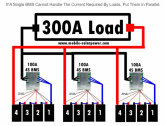Just like with discharging from all "packs" within the bank, the charge capacity is shared between the packs within the bank.
If you have Three 12V/100AH with 100A BMS packs, properly wired in parallel they should split the load demand & charge capacity. Should one pack reach "full" before the others the BMS should disconnect it to protect it from overcharging, the balance of charge power would then be split between the other two.
Typically with FET Based BMS', if the BMS is rated for 100A output, the most they can usually handle is generally 50A for Charging, or simpler yet 1/2 of what can be discharged. Using the same example, you'd have 300A Output capacity and 150A Charge capacity "collectively" from the bank.
To further on this, assuming 3 packs of 12V/100AH capacity, each with a FET based BMS capable of 100A discharge & 50A charge.
The load split can technically handle up to 300A max if all packs are active and it's all properly wired. If one pack reaches "Empty 'LVD' cut off" before the other 2, the load will be split between the two remaining, could only handle up to 200A Max Output.
Charging from SCC, Inverter/Charger or dedicated charger could only be 50A (limited by BMS). Now if you have 3 Packs being charged that is 50A ÷ 3 packs, then each pack is only getting about 16A so that will be a slow charge. If one pack hits full, then the 50A will be split between the remaining two and so on.
The Catch lurking in the bank !
Ultimately you are limited to the Maximum Amps that can be pushed for charge to the bank as a whole. Yes, if all three packs were at 20% SOC, you could push 150A and the three would take it BUT when Pack-A hit's full the available AMPS to Charge will be over what the other two BMS' can take and they would shut down to protect the packs. NOTE that Most "Common / general" LiFePo4 cells can handle 1C Rate for charge & discharge. which for a 100AH cell, that means up to 100A Charge / Discharge rate, the bigger the cells (ie: 280AH) the higher the amp capacity but also longer to charge or discharge as well.
Building to the "Common Denominator".
The two main factors here are Discharge Capacity and Charge Capacity which is relative to the battery packs within the bank as a whole.
The BMS chosen for each pack, should be able to handle the maximum load potential you intend to pull at any given time. Assume 300A max Load.
The BMS chosen should be capable of delivering the amount of amps to successfully charge your battery packs within the bank on the "Shortest Sun Hour Days" that you have in your region IF you are using Solar to charge your battery bank. (December in North America). This of course is determined by the size of the cells used and the number of packs within the bank as a whole.
On the two "forms" of BMS'.
There are two generalised types, Common-Port & Separate-Port. There are long threads on this here. In simple terms though, Common-Port uses one set of wires from the battery pack for both Charging & Discharging. Separate-Port uses one set of DC wires for the discharging and another set of DC wires for charging, so in effect, you have a One Way DC Bus for Charge and another separate One Way DC Bus for Discharging. Common-Port is the most commonly used form for Energy Storage because of generally simplicity and how the battery packs get charged. Separate-Port is most common in an EV scenario as there is an external charge facility of some sort and usually of high capacity or fast-charge type. It is more complicated than that but it's a simplistic quick view of it.
A common Mistake.
Many people quickly realize they can pull a heck of a lot of juice from their battery banks but very often they underestimate what it takes to charge those batteries and even more often, underestimate the amount of Sun Hours required to do so which should be calculated on the Lowest Sun Hour days. In Mid Summer if you can have your battery bank fully charge by 11:00 AM you're a happy camper but in December you get half the hours and by 17:00 (when it's getting dark) you only are half charged... It's important to not only have enough Solar Panels (Charge capability) but also enough Amperage from the solar controllers to fit the bank needs.
Reference Article on wiring your battery bank here:
Hope it helps, Good Luck.
Steve







